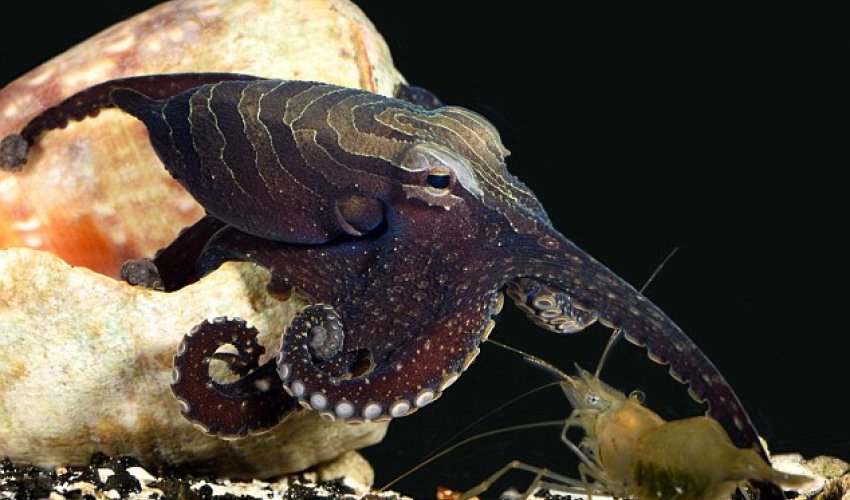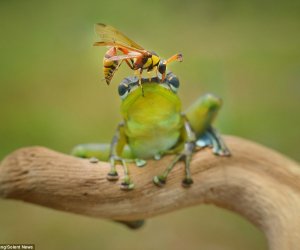Sneaky octopus tricks its prey by TAPPING

Lunch is a pantomime for an octopus that fools its prey into thinking it is behind it.
The larger Pacific striped octopus sneaks up on tasty shrimp, stretches one arm around it and taps it on the far shoulder - a common playground prank in schools around the world.
The startled shrimp then runs for safety, straight into its attacker's arms and belly.
The bizarre hunting technique emerged during research on the behaviour of the elusive octopus, which also revealed details of their tender mating strategies.
Most octopus simply snatch their prey with their long grasping arms in ambush attacks, usually by springing out of cover.
However, it seems the larger Pacific striped octopus prefers are more subtle approach.
Professor Ray Caldwell, a marine biologist at the University of California who was one of the team conducting the research, said: 'I've never seen anything like it.
'Octopuses typically pounce on their prey or poke around in holes until they find something.
'When this octopus sees a shrimp at a distance, it compresses itself and creeps up, extends an arm up and over the shrimp, touches it on the far side and either catches it or scares it into its other arms.'
The study, which is published in the journal Public Library of Science One, also revealed the octopus,which lives on the Pacific coast of Central America, is unusual in a number of other ways.
When mating, most male octopuses keep arms' distance away from the female for fear she will eat them.
The male larger Pacific striped octopus, however, has no such qualms, getting up close and personal with its mates.
Courting couples will share a den for a few days and snuggle up beak to beak and sucker to sucker, as if kissing and cuddling.
They will even share meals when in this unusual beak to beak position.
Unlike other octopuses, the females also do not die after laying their first clutch of eggs but mate time and time again.
The larger Pacific striped octopus is typically found living in water around 150 feet deep on muddy, sandy plains at the mouth of rivers, where it shelters in old shells or in rock cavities.
The animal, which was first discovered 40 years ago, grows to be around 3 inches (7cm) across, although males tend to be smaller at around two inches (4.5cm).
They exhibit a high contrast display of colours and patterns that can vary from pale to dark reddish brown to black with white stripes. They can have spots, smooth and uneven skin textures.
Although there have been many anecdotal reports of its unusual behaviour, scientists believed it to be too peculiar to be true and it has taken until now for it to be properly studied.
The researchers studied 40 individuals living in laboratory aquarium at the California Academy of Sciences.
Professor Caldwell said: 'They certainly respond to one another when they display their highly contrasting stripes and spots, so their coloration appears to be useful for group living.
'Nevertheless, while they tolerate one another and sometimes pair up, I don't think they are highly social.
'The next step to understanding the unique behaviors found in the larger Pacific striped octopus will be to observe groups in their natural habitat.
'Only by observing the context in which these behaviors occur in the wild can we begin to piece together how this octopus has evolved behaviors so radically different from what occurs in most other species of octopus.'
Dr Richard Ross, from the California Academy of Sciences and co author of the study, described the research as 'beyond exciting'.
Writing in the journal PLOS ONE, he added: 'It reminds us how much we still have to learn about the mysterious world of cephalopods.'
(Daily Mail)




www.ann.az
Similar news
Similar news
Latest news 
More news 



































 Photo
Photo 



 Video
Video 

